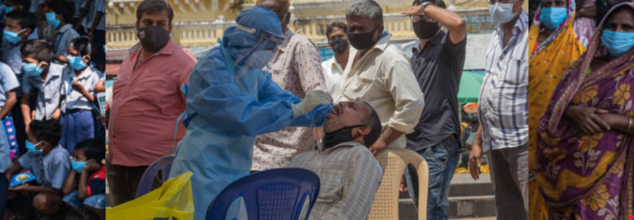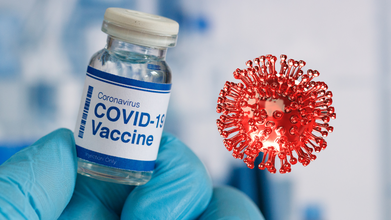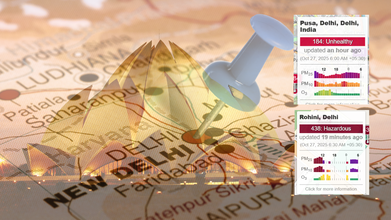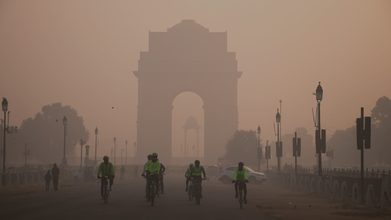- Health Conditions A-Z
- Health & Wellness
- Nutrition
- Fitness
- Health News
- Ayurveda
- Videos
- Medicine A-Z
- Parenting
- Web Stories
India Underreported Nearly 20 Lakh Excess Covid Deaths In 2021- Was Death Toll Really 6X Higher?

Credits: iStock
The second wave of Covid-19 in India was not just a crisis, it was a tragedy experienced in all corners of India. When oxygen supplies in hospitals ran out and funeral pyres were lit throughout the day and night, it was clear for everyone to see and feel how vast the devastation was. Family members lost dear ones within days, even hours. Yet, as dire as the situation appeared, recently published government statistics from India verify what many suspected- the actual death count was much worse. The official count of Covid deaths in 2021 was 3.3 lakh but the true excess deaths that year exceeded 20 lakh. That's almost six times greater than reported. The shocking gap indicates a trend of underreporting, bureaucratic obscurity, and political evasion, evoking international concern regarding transparency and accountability in pandemic governance.
India reported more than 1.02 crore deaths in 2021 — a whopping rise of almost 21 lakh from the last year — as per latest figures made public by India's Office of the Registrar General. In 2020, 81.2 lakh deaths were registered, and in 2019, the figure was 76.4 lakh. The surge in death, at the height of the second wave of the pandemic, sends red lights flashing immediately. Though not every one of these deaths can be attributed to Covid-19, the timing and the circumstances imply the virus contributed heavily, underreported.
Three official data sets — Sample Registration System (SRS), Civil Registration System (CRS), and Medical Certification of Cause of Death (MCCD) — were employed to assess trends in mortality. Of the three, CRS continues to be the most complete source, and it irrefutably indicates a record spike in deaths in 2021. All this is not only crucial for the realization of the pandemic's actual burden but also provides a prism into India's death registration and certification system failures.
Why the Official Covid Death Figures Don’t Add Up
The Union Ministry of Health had pegged the total number of Covid-19 deaths in 2021 at 3.3 lakh. However, the MCCD report, based on medically certified deaths, listed 4.13 lakh Covid-related fatalities. That alone suggests a significant gap. But here’s the critical twist: the MCCD data only covers 24 lakh deaths — just 23% of all deaths registered that year.
This difference suggests that there may not have been medical certification of numerous Covid-19 deaths, either because the healthcare infrastructure was burdened or because of systemic failure in certifying causes of death. Even among that smaller dataset, Covid-19 deaths exceeded the Health Ministry's figure, directly indicating official undercounting.
Maybe the most stark evidence of underreporting is from Gujarat. The BJP-ruled state had reported just 5,812 Covid deaths in 2021. But the actual number of deaths registered through CRS was 1.95 lakh — more than 33 times greater. Independent calculations by Kerala-based volunteer Krishna Prasad's dashboard reported that Gujarat had more than 2 lakh excess deaths that year.
Madhya Pradesh and West Bengal also had the same trends, with huge discrepancies between Covid-19 death claims and the actual amount of excess mortality. Madhya Pradesh had reported 6,927 official Covid deaths but had an excess of almost 2 lakh deaths over 2020. Uttar Pradesh, the most populous state of India, had an excess of 4.78 lakh deaths in 2021 when just 22,918 were officially claimed due to Covid-19. Kerala was an exception to the trend, having relatively more accurate death statistics.
What's Behind India's Spike in Crude Death Rate
Statisticians also reference the crude death rate, deaths per 1,000, as another insightful metric. From a consistent rate of 6 in both 2019 and 2020, it surged to 7.5 in 2021. This increase is not random; it reflects an abnormal spike in mortality concurrent with the pandemic peak.
If India's crude death rate of 6 in the historical years continued to 2021, the estimated deaths would have been approximately 82 lakh, consistent with previous years. The increased crude death rate in 2021 aligns with the 1.02 crore reported deaths very closely, implying over 20 lakh excess deaths, which cannot be accounted for by better registration.
In April 2022, the World Health Organization put India's estimated Covid-19 toll in 2020 and 2021 at 47 lakh deaths, either directly or indirectly due to the pandemic — eight-and-a-half times the number reported officially. India's government had dismissed the WHO report for being inappropriate in methodology for a country of the size of India. But interestingly enough, the very Registrar General of India whose figures have been quoted by the government is now lending strength to the suspicion of large-scale undercounting.
The contrast is stark: India dismissed international models as speculative, but its own official statistics now confirm excess deaths in line with WHO estimates. This is a matter of profound concern regarding data suppression, political motive, and the right of citizens and the international health community to the truth.
Why Accurate Data Matters?
Mortality data accurately gathered matters more than numbers. It affects how nations prepare for pandemics, how resources are allocated to healthcare, and how people have faith in public institutions. For India, the world health leader and manufacturer of vaccines, poor data transparency erodes credibility and undermines global cooperation in public health.
Additionally, for the uncounted families many of whom were denied medical care, social acceptance, and economic ruin, the government silence is another injustice. Without official acknowledgment, they're typically not given government compensation, aid, or even recognition.
The information is now out presenting how India saw a mortality spike in 2021 that is more than six times bigger than its official Covid-19 death toll. It matters little whether the cause is deliberate cover-up or systemic failure- the result is the same- the lives lost in secrecy amount to millions.
Going forward, India has to build stronger health data infrastructure, conduct independent audits, and uphold transparency. The world witnessed the funeral pyres burn and now, the figures finally tell us the unthinkable truth many had suspected all along.
New 'Frankenstein' Covid Variant, Now Called The 'Halloween Monster In The Air' Is Spreading Faster Than Ever, What Makes It So Unique?

Credits: Canva
The new 'Frankenstein' variant of COVID-19 is spreading rapidly. It has been largely ignored, however, this new SARS-CoV-2 variant is causing high levels of sickness absence in nurseries, schools and care facilities and will also increase the number of long COVID patients.
It is the same as the Stratus variant, scientifically known as XFG. It is nicknamed as 'Frankenstein'. Many are also calling this variant the "Halloween Monster in the Air", as it has led to a 37% spike in hospital visits in France.
What Is Happening In The World?
In a very short time, the "Stratus" variant has become the dominant strain. In Germany, it has accounted for 84% of identified SARS-CoV-2 variants at the beginning of October 2025. This variant is also the dominant one in Austria and Switzerland, making up for about 80% of viral load in wastewater.
As per the Robert Koch Institute (RKI), it has also led to rise in acute respiratory illnesses since September. The Frankenstein virus has affected people across ages.
Why Is It Called 'Frankenstein' Variant?
The new variant gets its name 'Frankenstein' due to its genetic fusion of components from different virus types, which makes it an accurate description of a genetic monster. The new 'Frankenstein' Covid variant is a recombinant variant formed from the Omicron lineages LF.7 and LP.8.1.2. The fusion has led to a more resistant and "fitter" strain.
As per the World Health Organization (WHO), the rise in Covid-19 cases are also associated with the same variant. It has been classified by the WHO as a variant under monitoring since June 25, 2025. The evidence while show that the additional public health risk is low worldwide, the mutation makes it more contagious, thus the growing number of cases.
What Makes The New 'Frankenstein' Covid Variant So Unique?
The symptoms, while some of them are quite similar to that of we know from COVID-19, there are some unusual symptoms too, which were often associated with a common cold:
- Sore throat
- Runny nose and congestion
- Dry cough
- Fatigue and muscle pain
- Mild fever
- Loss of appetite
- Shortness of breath
- Chest pain
- High fever in people with lower or weakened immunity system
What Are The Ways You Could Prevent The New 'Frankenstein' Covid Variant?
At present, there is no specific treatment available for the Frankenstein variant. The approach remains similar to that for other COVID-19 strains, focusing on managing symptoms according to how the illness progresses.
Vaccination: Current vaccines are believed to help reduce the risk of severe illness and hospitalization. While their effectiveness may slightly decrease against new variants, they continue to play a crucial role in prevention.
Supportive care: Simple measures such as taking fever-reducing medications, staying well-hydrated, getting enough rest, and using cough suppressants can help ease symptoms.
Preventive practices: Wearing a mask, maintaining proper hand hygiene, avoiding crowded spaces, and keeping a safe distance from others remain key protective steps.
As research on the Frankenstein variant continues, individual protective measures are vital. Because the illness can affect each person differently, it’s important to consult a healthcare professional if symptoms appear.
Delhi Pollution Left People Gasping For Air, But There Are Ways To Stay Safe According To Doctor

Credits: Canva and AQIcn.org
After some days of relief, on Sunday, Delhi again woke up to a thick layer of smog, with pollution levels rising up to 'very poor' category. The centre's early warning system (EWS) forecast that air quality index (AQI) will further deteriorate.
On Sunday, by 7pm, Delhi's AQI was at 299, just below 'very poor' level on the index. Anand Vihar remained at severe levels with the AQI logged at 421 at 11am, by evening, it rose to 428. Wazirpur also slipped into the 'severe' category with an AQI of 408.
As Delhi continues to struggle with smog-filled skies, and thick layer of smoke to breathe through, an earlier video by Dr Divya Prakash, Consultant Physician at Yashoda Hospital on tips to stay safe amid Delhi pollution is making rounds.
What Does The Doctor Say?
Dr Prakash points out that the moment the index goes above 50, the air starts to become unhealthy for us, however, in Delhi, we already see the AQI levels crossing the 400 threshold.
"The main problem is with our lungs due to increasing air pollution. It also indirectly affects our heart and brain. So, how can we save ourselves from this?" He shares that the best way is to use public transports and electric vehicles. He also recommends wearing a mask whenever anyone goes out and urges people to avoid going out at peak hours.
"Eat healthy food, avoid burning wood or construction work around the house and do use your air purifier at home, especially for children and elderly and those who already have lung or other heart problems," he says.
How Poor AQI Impacts Our Lungs?
Air pollution comprises of tiny pollutants and particles called the PM2.5 and PM10, that reach deep into our lungs. These particles, though tiny, are able to inflame the airways and cause breathlessness, wheezing, and repeated coughing. This can further cause healthy adults to suffer from throat irritation, headaches, and fatigue if they are exposed for a long time.
Since children inhale more air per kilogram of body weight than adults, they are at more risk of being harmed by the pollutants. Furthermore, they also have a weaker immunity, which puts them at more risk of such complications.
The World Health Organization (WHO) also notes that not just lungs, but almost every organ in the body can be impacted by air pollution. Thanks to the small size of the pollutants, they can penetrate into the bloodstream via lungs and then circulate throughout the body and could lead to systemic inflammation and carcinogenicity.
What Diseases Could Air Pollution Cause?
Apart from the respiratory diseases like asthma, shortness of breath, COPD, WHO notes that air pollution could is a risk for all-cause mortality as well as diseases like:
- Stroke
- Ischaemic heart disease
- Lung cancer
- Pneumonia
- Cataract
There are evidence that support the link between air pollution exposure and adverse pregnancy outcomes, including low birth weight of the child, small for gestational age, and other cancers, diabetes, and cognitive impairment and neurological disorders in the child.
How Can You Read AQI?
As per the Central Pollution Control Board, here's how the data on AQI can be interpreted
- 0-50 is considered ‘good’
- 51-100 is considered ‘satisfactory’
- 101-200 is considered ‘moderate’
- 201-300 is considered ‘poor’
- 301-400 is considered ‘very poor’
- 401-500 is considered ‘severe’
Delhi’s Air Quality Slips Back to ‘Very Poor’; Toxic Air Could Cause Acute Health Effects, Warns AIIMS Doctor

Credits: Canva
Delhi witnessed a slight improvement in its Air Quality Index (AQI) for a couple of days before it again slipped back to 'very poor' category. On Sunday morning, some areas in fact reached 'severe' category on the AQI.
While pollution spiked during Diwali, on Friday and Saturday, Delhi's AQI was recorded at 275 and 292 respectively, which has placed the air quality category in 'poor'.
However, on Sunday morning, Delhiites woke up to 'very poor' air quality, thanks to the thick layer of smog. The AQI was recorded well above 300 in most areas. Visuals too show low visibility in many areas of the national capital.
What Does The Expert Say About The Air Quality?
On Sunday, as of 7am, Delhi's Anand Vihar area recorded an AQI of 430, which has placed it under the 'severe' category. Wazirpur also recorded an AQI of 403, further placing it under the 'severe' category. Speaking to ANI, former AIIMS Director Dr Randeep Guleria urged people to use preventative measures in order to minimize their exposure to the polluted air. He also warned people of the health implications which could be the result of deteriorating air quality.
"The current high levels of air pollution, indicated by poor AQI, are leading to acute health effects, particularly among individuals with underlying heart or lung conditions, the elderly, and young children. These groups are experiencing increased chest discomfort, breathing difficulty, cough, and worsening of pre-existing conditions like asthma and COPD," Dr Guleria told ANI, on Friday.
"Even healthy individuals are reporting symptoms such as nasal stuffiness, throat pain, chest tightness, and coughing. The inflammation and narrowing of airways caused by pollutants are contributing to these issues. Additionally, the use of crackers, despite permissions for 'green crackers,' has exacerbated air pollution," he added.
What Preventative Measures Should One Use?
The best way to protect yourself is by limiting your outdoor timings, especially during the early morning hours and at the night. Smog is at its lowest during the afternoon. Furthermore, using an N-95 respirator could protect you from the minute pollutant particles in the air.
N-95 is a respiratory protective device designed to achieve a very close facial fit and very efficient filtration of airborne particles, notes the FDA. This is what makes it fit for use during high levels of pollution.
The edges of N-95 are designed to form a seal around the nose and mouth. Some models even have exhalation valves that can make breathing out easier and help reduce the heat build-up.
As per a 2021 study published in the Indian Journal of Radiology and Imaging, the N-95 mask could block "at least 95% of very small test particles".
Read More: Which Mask To Wear For Best Protection?
What Does AQI Mean?
As per the Central Pollution Control Board, here's how the data on AQI can be interpreted
- 0-50 is considered ‘good’
- 51-100 is considered ‘satisfactory’
- 101-200 is considered ‘moderate’
- 201-300 is considered ‘poor’
- 301-400 is considered ‘very poor’
- 401-500 is considered ‘severe’
Delhi AQI as of 7am
Alipur, Delhi (DPCC) - 309.00
Anand Vihar, Delhi (DPCC) - 430.00
Ashok Vihar, Delhi (DPCC) - 369.00
Aya Nagar, Delhi (IMD) - 272.00
Bawana, Delhi (DPCC) - 390.00
Burari Crossing, Delhi (IMD) - 344.00
CRRI Mathura Road, Delhi (IMD) - 330.00
Chandni Chowk, Delhi (IITM) - 376.00
DTU, Delhi (CPCB) - 266.00
Dr. Karni Singh Shooting Range, Delhi (DPCC) - 317.00
Dwarka-Sector 8, Delhi (DPCC) - 301.00
IGI Airport (T3), Delhi (IMD) - 269.00
IHBAS, Dilshad Garden, Delhi (CPCB) - 310.00
ITO, Delhi (CPCB) - 329.00
Jahangirpuri, Delhi (DPCC) - 370.00
Jawaharlal Nehru Stadium, Delhi (DPCC) - 304.00
© 2024 Bennett, Coleman & Company Limited

